PurC
更新说明
PurC 源码仓库:PurC
此项目由魏老师团队开发,本人也参与了部分代码贡献。
详细使用问题可以到 purc 仓库反馈。
目前 purc README.md 暂时没有提供中文版本,欢迎有志之士参与贡献。
项目仓库有一些例子,可以跑起来试试;通过跑例子可以验证环境是否有问题。
Arch Linux 的 AUR 仓库我有提供相应的软件包,其他操作系统用户可以参考 AUR 中的打包脚本自行修改编译
(注:一般按照 AUR 的编译脚本都能编译成功,安装时需要针对不同操作系统进行安装路径调整。)。
如有 PurC 环境编译问题可以到 PurC 仓库反馈。
PurC is the prime HVML interpreter for C language.
Table of Contents
Introduction
HVML is a descriptive programming language proposed and designed by Vincent Wei,
who is the author of the China-first open source project - MiniGUI.
PurC is the acronym of the Prime HVML inteRpreter for C language.
It is also the abbreviation of Purring Cat,
while Purring Cat is the nickname and the mascot of HVML.
The goal of PurC is to implement all features defined by HVML Specifiction V1.0
and all predefined dynamic objects defined by HVML Predefined Variables V1.0 in C language.
You can use PurC to run an HVML program or an HVML app by using the command line tool purc,
or use PurC as a library to build your own HVML interpreter.
We release PurC under LGPLv3, so it is free for commercial use if you follow the conditions and terms of LGPLv3.
This is the version 0.9.2 of PurC.
By now, PurC provides support for Linux and macOS.
The support for Windows is on the way.
We welcome anyone to port PurC to other platforms.
To learn the basic concepts about HVML programming, please refer to the following tutorial:
For more information about HVML, please refer to the article (10% complete):
For documents, specifications, and open source software related to HVML, please refer to the following repositories:
Note that, since PurC 0.9.0, we merged the repositories of DOM Ruler and PurC Fetcher to this repository.
Therefore, the following repositories were marked deprecated:
- PurC Fetcher (the remote data fetcher for PurC).
- DOM Ruler (A library to maintain a DOM tree, lay out and stylize the DOM elements by using CSS).
Building PurC
Note that, if you are seeking the pre-built packages for platforms such as Ubuntu, Deepin, Homebrew, and MSYS2, you can refer to the following page:
https://hvml.fmsoft.cn/software
Prerequistes
To build PurC from source code, please make sure that the following tools or libraries are available on your Linux or macOS system:
- cmake
- A C11 and CXX17 compliant complier: GCC 8+ or Clang 6+
- Zlib 1.2.0 or later
- Glib 2.44.0 or later
- Python 3
- BISON 3.0 or later
- FLEX 2.6.4 or later
Although the port for Windows is still on the way, it is possible to build PurC on Windows 10 version 2004 or later:
You can install WSL (Windows Subsystem for Linux) and a Linux distribution, e.g., Ubuntu, on your Windows system,
then build PurC in Ubuntu environment.
Building steps
We assume that you are using Linux.
After fetched the source of PurC, you can change to the root of the source tree,
and use the following command line to build and install PurC:
$ cmake -DCMAKE_BUILD_TYPE=RelWithDebInfo -DPORT=Linux -B build && cmake --build build && sudo cmake --install build
The above command line consists of the following commands:
cmake -DCMAKE_BUILD_TYPE=RelWithDebInfo -DPORT=Linux -B build: Change to the build/
subdirectory and run cmake to generate the building files to build PurC.
Note that this command uses the following options:
-DCMAKE_BUILD_TYPE=RelWithDebInfo: Specify the building type is RelWithDebInfo.
You can also use Debug, Release and other options supported by cmake.-DPORT=Linux: Tell cmake you are building PurC for an operating system
based on Linux kernel. Use -DPORT=Mac if you are using macOS.-B build: Generate building files in build/ subdirectory.
cmake --build build: Build PurC in build/ subdirectory.sudo cmake --install build: Install PurC from build/ subdirectory.
You can also use the following commands to build and install PurC step by step:
$ cd <path/to/the/root/of/the/source/tree/of/PurC>
$ rm -rf build/
$ mkdir build/
$ cd build/
$ cmake -DCMAKE_BUILD_TYPE=Release -DPORT=Linux ..
$ make -j4
$ sudo make install
If you'd like to use ninja instead of make to build PurC,
you can use the following commands:
$ cd <path/to/the/root/of/the/source/tree/of/PurC>
$ cmake -DCMAKE_BUILD_TYPE=RelWithDebInfo -DPORT=Linux -Bbuild -GNinja && ninja -Cbuild && sudo ninja -Cbuild install
Note that you might need to remove build/ directory first if there is already one.
By default, the above commands will build PurC and install the headers, libraries, executables,
and some documents to your system (under /usr/local/ directory if you are using Linux system).
When using make, you can use DESTDIR to specify an alternative installation directory:
$ make DESTDIR=/package/stage install
When using ninja, you can also use DESTDIR to specify an alternative installation directory:
$ DESTDIR="/package/stage" ninja -Cbuild install
Environment Variables
PurC uses the following environment variables for different purposes:
PURC_DVOBJS_PATH: the path to save the shared modules for external dynamic objects.PURC_EXECUTOR_PATH: the path to save the shared modules for external executors.PURC_FETCHER_EXEC_PATH: the path to save the executable program of PurC Fetcher.PURC_USER_DIR_SUFFIX: The directory suffix for user.PURC_LOG_ENABLE: true if enable the global log facility.PURC_LOG_SYSLOG: true if enable to use syslog as the log facility.
Using purc
The following sections assume that you have installed PurC to your system,
and the command line tool purc has been installed into /usr/local/bin/.
Make sure that you have added /usr/local/lib to /etc/ld.so.conf and run sudo ldconfig command,
in order that the system can find the shared library of PurC you just installed into /usr/local/lib.
Run a single HVML program
Please save the following contents in a file named hello.hvml as your
first HVML program in your working directory:
<!DOCTYPE hvml>
<hvml target="void">
$STREAM.stdout.writelines('Hello, world!')
</hvml>
To run this HVML program, you can use purc in the following way:
$ purc hello.hvml
You will see that your first HVML program prints Hello, world!
on your terminal and quit:
Hello, world!
You can also run this HVML program directly as a script if you prepend the
following line as the first line in your HVML program:
#!/usr/local/bin/purc
After this, run the following command to change the mode of the file to have
the executing permission:
$ chmod +x hello.hvml
then run hello.hvml directly from the command line:
$ ./hello.hvml
Run a HVML program with errors or exceptions
Please save the following contents in a file named error.hvml in your working directory:
<!DOCTYPE hvml>
<hvml target="void">
$STREAM.stdout.writelines('Hello, world!)
</hvml>
Apparently, we forget the second single quote of Hello, world!.
The interperter will exit with a nozero return value if you run purc without any options:
$ purc error.hvml
$ echo $?
1
You can run purc with the option -v for a verbose message:
$ purc -v error.hvml
purc 0.9.2
Copyright (C) 2022 FMSoft Technologies.
License GPLv3+: GNU GPL version 3 or later <http://gnu.org/licenses/gpl.html>
This is free software: you are free to change and redistribute it.
There is NO WARRANTY, to the extent permitted by law.
Failed to load HVML from file:///srv/devel/hvml/purc/build/error.hvml: pcejson unexpected eof parse error
Parse file:///srv/devel/hvml/purc/build/error.hvml failed : line=7, column=1, character=0x0
This time, purc reported the error it encountered when it was parsing the HVML program: the wrong line and column.
If you change the program to add the missing single quote, purc will be happy to execute the HVML program.
For an uncaught runtime exception, purc will dump the executing stack.
For an example, you can save the following program as exception.hvml:
<!DOCTYPE hvml>
<hvml target="void">
<iterate on 0 onlyif $L.lt($0<, 10) with $DATA.arith('+', $0<, 1) nosetotail >
$STREAM.stdout.writelines("$0<) Hello, world! $CRTN.foo")
</iterate>
</hvml>
This HVML program refers to an inexistent property (foo) of $CRTN.
Run purc to execute this HVML program with -b option, it will report the executing stack:
$ purc -v exception.hvml
purc 0.9.2
Copyright (C) 2022 FMSoft Technologies.
License GPLv3+: GNU GPL version 3 or later <http://gnu.org/licenses/gpl.html>
This is free software: you are free to change and redistribute it.
There is NO WARRANTY, to the extent permitted by law.
Executing HVML program from `file:///srv/devel/hvml/purc/build/exception.hvml`...
The main coroutine terminated due to an uncaught exception: NoSuchKey.
>> The document generated:
>> The executing stack frame(s):
#00: <iterate on=0 onlyif=$L.lt( $0<, 10 ) with=$DATA.arith( "+", $0<, 1 ) nosetotail>
ATTRIBUTES:
on: 0
onlyif: true
with: 1L
CONTENT: `NoSuckKey` raised when evaluating the experssion: $STREAM.stdout.writelines( "$0<) Hello, world! $CRTN.foo" )
Variant Creation Model: callGetter(getElement(getElement(getVariable("STREAM"),"stdout"),"writelines"),concatString(getVariable("0<"),") Hello, world! ",getElement(getVariable("CRTN"),"foo")))
Call stack:
#00: $CRTN.foo
Variant Creation Model: getElement(getVariable("CRTN"),"foo")
#01: "$0<) Hello, world! $CRTN.foo"
Variant Creation Model: concatString(getVariable("0<"),") Hello, world! ",getElement(getVariable("CRTN"),"foo"))
#02: $STREAM.stdout.writelines( "$0<) Hello, world! $CRTN.foo" )
Variant Creation Model: callGetter(getElement(getElement(getVariable("STREAM"),"stdout"),"writelines"),concatString(getVariable("0<"),") Hello, world! ",getElement(getVariable("CRTN"),"foo")))
CONTEXT VARIABLES:
< 0
@ null
! {}
: null
= null
% 0UL
^ null
#01: <hvml target="void">
ATTRIBUTES:
target: "void"
CONTENT: undefined
CONTEXT VARIABLES:
< null
@ null
! {}
: null
= null
% 0UL
^ null
Run multiple HVML programs in parallel
PurC can run multiple HVML programs as coroutines in parallel.
For example, we enhance the first HVML program to print Hello, world! 10 times:
<!DOCTYPE hvml>
<hvml target="void">
<iterate on 0 onlyif $L.lt($0<, 10) with $DATA.arith('+', $0<, 1) nosetotail must-yield >
$STREAM.stdout.writelines(
$STR.join($0<, ") Hello, world! --from COROUTINE-", $CRTN.cid))
</iterate>
</hvml>
Assume you named the enhanced version as hello-10.hvml,
we can run the program as two coroutines in parallel by specifying the command line flag -l:
$ purc -l hello-10.hvml hello-10.hvml
You will see the following output on your terminal:
0) Hello, world! -- from COROUTINE-3
0) Hello, world! -- from COROUTINE-4
1) Hello, world! -- from COROUTINE-3
1) Hello, world! -- from COROUTINE-4
2) Hello, world! -- from COROUTINE-3
2) Hello, world! -- from COROUTINE-4
3) Hello, world! -- from COROUTINE-3
3) Hello, world! -- from COROUTINE-4
4) Hello, world! -- from COROUTINE-3
4) Hello, world! -- from COROUTINE-4
5) Hello, world! -- from COROUTINE-3
5) Hello, world! -- from COROUTINE-4
6) Hello, world! -- from COROUTINE-3
6) Hello, world! -- from COROUTINE-4
7) Hello, world! -- from COROUTINE-3
7) Hello, world! -- from COROUTINE-4
8) Hello, world! -- from COROUTINE-3
8) Hello, world! -- from COROUTINE-4
9) Hello, world! -- from COROUTINE-3
9) Hello, world! -- from COROUTINE-4
In the above output, COROUTINE-3 and COROUTINE-4 contain the coroutine identifier assigned by PurC for two running instances of the program.
You see that PurC schedules the running instances to execute alternately, i.e., in the manner of coroutines.
If you do not use the flag -l in the command line, purc will run the programs one by one:
$ purc hello-10.hvml hello-10.hvml
0) Hello, world! -- from COROUTINE-3
1) Hello, world! -- from COROUTINE-3
2) Hello, world! -- from COROUTINE-3
3) Hello, world! -- from COROUTINE-3
4) Hello, world! -- from COROUTINE-3
5) Hello, world! -- from COROUTINE-3
6) Hello, world! -- from COROUTINE-3
7) Hello, world! -- from COROUTINE-3
8) Hello, world! -- from COROUTINE-3
9) Hello, world! -- from COROUTINE-3
0) Hello, world! -- from COROUTINE-4
1) Hello, world! -- from COROUTINE-4
2) Hello, world! -- from COROUTINE-4
3) Hello, world! -- from COROUTINE-4
4) Hello, world! -- from COROUTINE-4
5) Hello, world! -- from COROUTINE-4
6) Hello, world! -- from COROUTINE-4
7) Hello, world! -- from COROUTINE-4
8) Hello, world! -- from COROUTINE-4
9) Hello, world! -- from COROUTINE-4
Connecting to HVML renderer
One of important differences between HVML and other programming languages is that HVML can generate documents described in markup languages like HTML,
not just output data to a file or your terminal.
For your convenience, we have prepared some HVML samples in the directory Source/Samples/hvml of this repository.
After building PurC, the samples will be copied to the building root directory, under hvml/ subdirectroy,
so that you can change to the building root directory and use purc to run the samples.
For example:
$ cd <path/to/the/building/directory/>
$ purc hvml/fibonacci-void-temp.hvml
This HVML program will output 18 Fibonacci numbers less than 2000.
There is also another version of this program: hvml/fibonacci-html-temp.hvml.
It will generate an HTML document listing the Fibonacci numbers.
If you run hvml/fibonacci-html-temp.hvml program by using purc without any option,
purc will use the renderer called HEADLESS.
This renderer will record the messages sent by PurC to the renderer to a local file,
it is /dev/null by default on Linux.
Because this HVML program did not use $STREM.stdout any more, you will see nothing on your terminal.
But you can use the option --verbose (or the short option -b) to show the HTML contents generated by the HVML program in your terminal:
$ purc -v hvml/fibonacci-html-temp.hvml
The command will give you the following output:
purc 0.9.2
Copyright (C) 2022 FMSoft Technologies.
License GPLv3+: GNU GPL version 3 or later <http://gnu.org/licenses/gpl.html>
This is free software: you are free to change and redistribute it.
There is NO WARRANTY, to the extent permitted by law.
Executing HVML program from `file:///srv/devel/hvml/purc/build/hvml/fibonacci-html-temp.hvml`...
The main coroutine exited.
>> The document generated:
<html>
<head>
<title>Fibonacci Numbers
</title>
</head>
<body id="theBody">
<h1>Fibonacci Numbers less than 2000
</h1>
<ol>
<li>0
</li>
<li>1
</li>
<li>1
</li>
<li>2
</li>
<li>3
</li>
<li>5
</li>
<li>8
</li>
<li>13
</li>
<li>21
</li>
<li>34
</li>
<li>55
</li>
<li>89
</li>
<li>144
</li>
<li>233
</li>
<li>377
</li>
<li>610
</li>
<li>987
</li>
<li>1597
</li>
</ol>
<p>Totally 18 numbers
</p>
</body>
</html>
>> The executed result:
[ 18, 1597 ]
purc now contains a built-in renderer called Foil.
This renderer can show the contents of the target document in your terminal:
$ purc --rdr-comm=thread hvml/fibonacci-html-temp.hvml
Fibonacci Numbers less than 2000
1. 0
2. 1
3. 1
4. 2
5. 3
6. 5
7. 8
8. 13
9. 21
10. 34
11. 55
12. 89
13. 144
14. 233
15. 377
16. 610
17. 987
18. 1597
Totally 18 numbers
Note that in current version (0.9.2), Foil is not fully functional.
In the near future, Foil will provide support for most features of CSS 2.2 and some features of CSS Level 3,
in order that you can get the similiar experience like a web browser.
You can also direct purc to connect to a graphics renderer, for example, xGUI Pro.
It is an advanced HVML renderer based on WebKit.
Assume that you have installed xGUI Pro on your system,
you can run purc to show the ultimate HTML contents in a window of xGUI Pro.
Please refer to https://github.com/HVML/xGUI-Pro for detailed instructions to install xGUI Pro.
Assume that you have started xGUI Pro from another terminal, then please run purc with the following options:
$ purc --rdr-comm=socket hvml/fibonacci-html-temp-rdr.hvml
Note that, in the above command line, we execute a modified version of Fibonacci Numbers: hvml/fibonacci-html-temp-rdr.hvml.
If you compare these two versions, you will find that there is an observe element in the modified version:
<observe on $CRTN for "rdrState:pageClosed">
<exit with [$count, $last_two] />
</observe>
If there is no such observe element, the HVML program will exit immediately after generated the HTML document.
By using the observe element, the HVML program will wait for the time when the page created by the renderer is closed by the user (that is you).
You will see that the contents in a window of xGUI Pro created by hvml/fibonacci-html-temp-rdr.hvml:
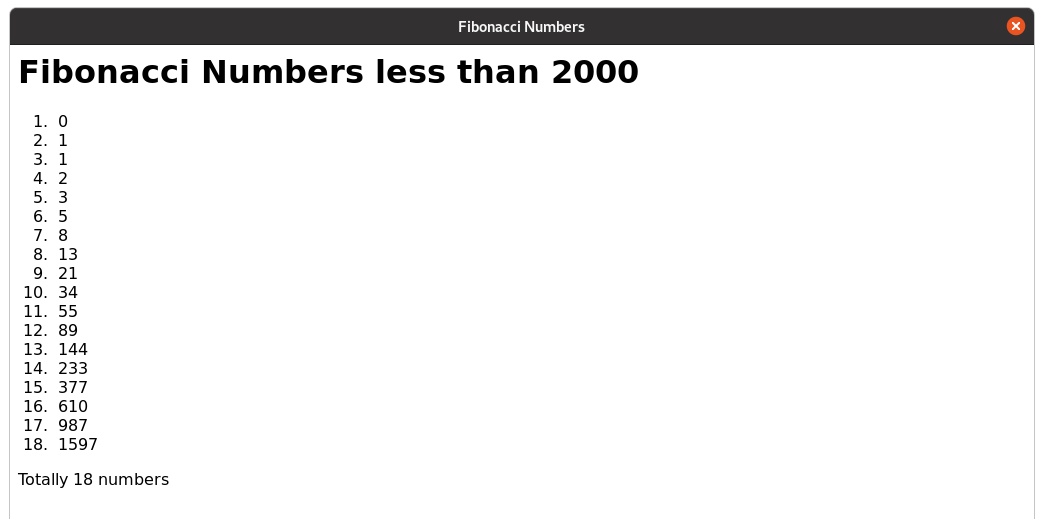
If you close the window by clicking the close box on the caption bar,
the HTML program will exit as normally.
For a complete HVML program which gives a better experience,
you can try to run another sample called hvml/calculator-bc.hvml, which implements an arbitrary precision calculator:
$ purc -p purcmc hvml/calculator-bc.hvml
Here is the screenshot of hvml/calculator-bc.hvml:
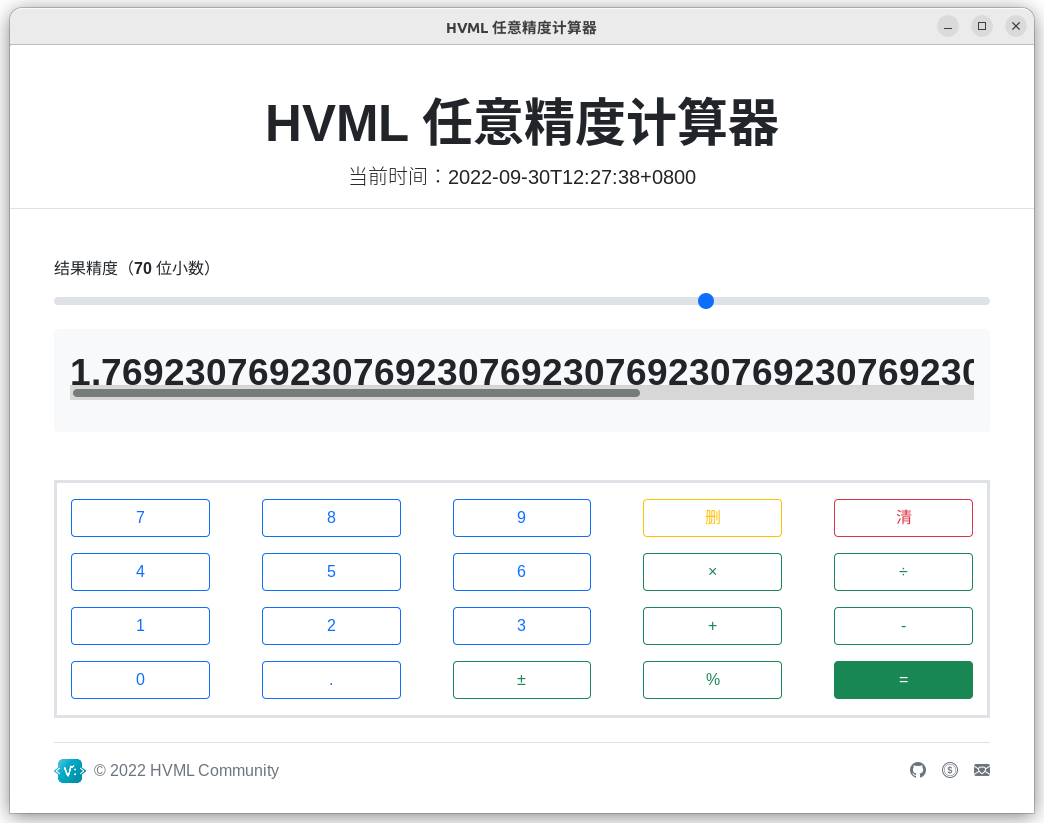
Or run hvml/planetary-resonance-lines.hvml, which shows the Planetary Resonance:
$ purc -p purcmc hvml/planetary-resonance-lines.hvml
Here is the screenshot of hvml/planetary-resonance-lines.hvml:
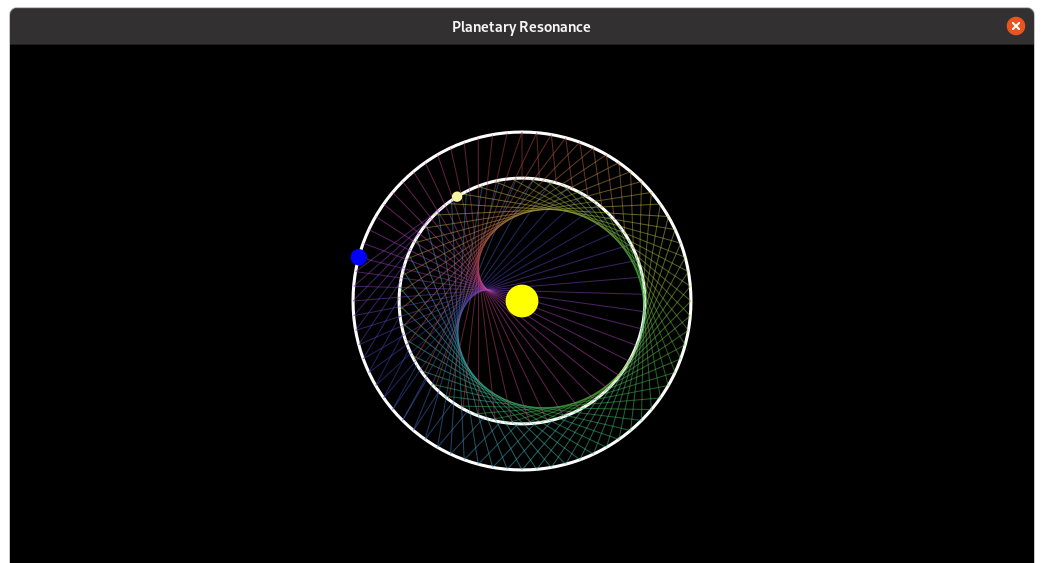
For an amazing HVML program which uses the multiple coroutines to sieve the prime numbers,
you can run hvml/prime-number-sieve.hvml, which visually illustrates the prime number sieve algorithm:
$ purc -p purcmc hvml/prime-number-sieve.hvml
Here is the screenshot of hvml/prime-number-sieve.hvml:

Options for purc
You can see the all options supported by purc when you run purc with -h option:
$ purc -h
purc (0.9.2) - a standalone HVML interpreter/debugger based-on PurC.
Copyright (C) 2022 FMSoft Technologies.
License GPLv3+: GNU GPL version 3 or later <http://gnu.org/licenses/gpl.html>
This is free software: you are free to change and redistribute it.
There is NO WARRANTY, to the extent permitted by law.
Usage: purc [ options ... ] [ file | url ] ... | [ app_desc_json | app_desc_ejson ]
The following options can be supplied to the command:
-a --app=< app_name >
Run with the specified app name (default value is `cn.fmsoft.hvml.purc`).
-r --runner=< runner_name >
Run with the specified runner name (default value is `main`).
-d --data-fetcher=< local | remote >
The data fetcher; use `local` or `remote`.
- `local`: use the built-in data fetcher, and only `file://` URLs
supported.
- `remote`: use the remote data fetcher to support more URL schemas,
such as `http`, `https`, `ftp` and so on.
-c --rdr-comm=< headless | thread | socket >
The renderer commnunication method; use `headless` (default), `thread`, or `socket`.
- `headless`: use the built-in headlesss renderer.
- `thread`: use the built-in thread-based renderer.
- `socket`: use the remote socket-based renderer;
`purc` will connect to the renderer via Unix Socket or WebSocket.
-u --rdr-uri=< renderer_uri >
The renderer uri:
- For the renderer comm method `headleass`,
default value is `file:///dev/null`.
- For the renderer comm method `thread`,
default value is `edpt://localhost/cn.fmsoft.hvml.renderer/foil`.
- For the renderer comm method `socket`,
default value is `unix:///var/tmp/purcmc.sock`.
-j --request=< json_file | - >
The JSON file contains the request data which will be passed to
the HVML programs; use `-` if the JSON data will be given through
STDIN stream. (Ctrl+D for end of input if you input the JSON data in a terminal.)
-q --query=< query_string >
Use a URL query string (in RFC 3986) for the request data which will be passed to
the HVML programs; e.g., --query='case=displayBlock&lang=zh'.
-l --parallel
Execute multiple programs in parallel.
-v --verbose
Execute the program(s) with verbose output.
-C --copying
Display detailed copying information and exit.
-V --version
Display version information and exit.
-h --help
This help.
Run an HVML app in mutiple runners
PurC supports to run an app in multiple runners.
Here one runner is one thread in the purc process.
For this purpose, you can prepare a JSON file or an eJSON file which defines the app, the runners,
and the initial HVML programs to run as coroutines in different runners.
Here is an example:
{
"app": "cn.fmsoft.hvml.sample",
"runners": [
{
"runner": "Products",
"renderer": { "protocol": "purcmc", "uri": "unix:///var/tmp/purcmc.sock",
"workspaceName": "default", "workspaceLayout": "cn.fmsoft.hvml.sample/layout.html" },
"coroutines": [
{ "url": "cn.fmsoft.hvml.sample/productlist.hvml", "request": {},
"renderer": { "pageType": "widget", "pageName": "productlist", "pageGroupId": "theProductsArea" }
},
{ "url": "cn.fmsoft.hvml.sample/productinfo.hvml", "request": { "productId": 0 },
"renderer": { "pageType": "widget", "pageName": "productinfo", "pageGroupId": "theProductsArea" }
}
]
},
{
"runner": "Customers",
"renderer": { "protocol": "purcmc", "uri": "unix:///var/tmp/purcmc.sock",
"workspaceName": "default", "workspaceLayout": "cn.fmsoft.hvml.sample/layout.html" },
"coroutines": [
{ "url": "cn.fmsoft.hvml.sample/customerlist.hvml", "request": {},
"renderer": { "pageType": "widget", "pageName": "customerlist", "pageGroupId": "theCustomersArea" }
},
{ "url": "cn.fmsoft.hvml.sample/customerlist.hvml", "request": { "customerId": 0 },
"renderer": { "pageType": "widget", "pageName": "customerinfo", "pageGroupId": "theCustomersArea" }
}
]
},
{
"runner": "Daemons",
"coroutines": [
{ "url": "cn.fmsoft.hvml.sample/check-customers.hvml", "request": { "interval": 10 } },
{ "url": "cn.fmsoft.hvml.sample/check-products.hvml", "request": { "interval": 30 } }
]
},
]
}
Assume that you prepare all HVML programs and save the above JSON as cn.fmsoft.hvml.sample.json,
you can run purc in the following way:
$ purc cn.fmsoft.hvml.sample.json
Note that, when running an app in this way,
you can use the command line options in the eJSON file through the variable $OPTS prepared by purc when parsing the eJSON file.
This gives a typical application of parameterized eJSON introduced by PurC.
For example, we can specified the command line options:
$ purc --app=cn.fmsoft.hvml.sample my_app.ejson
Then use the option specified by --app in my_app.ejson:
{
"app": "$OPTS.app",
"runners": [
{
"runner": "Products",
"renderer": { "protocol": "purcmc", "uri": "unix:///var/tmp/purcmc.sock",
"workspaceName": "default", "workspaceLayout": "$OPTS.app/layout.html" },
"coroutines": [
{ "url": "cn.fmsoft.hvml.sample/productlist.hvml", "request": {},
"renderer": { "pageType": "widget", "pageName": "productlist", "pageGroupId": "theProductsArea" }
},
{ "url": "cn.fmsoft.hvml.sample/productinfo.hvml", "request": { "productId": 0 },
"renderer": { "pageType": "widget", "pageName": "productinfo", "pageGroupId": "theProductsArea" }
},
]
},
]
}
All occurrences of $OPTS.app in my_app.ejson will be subsituted by cn.fmsoft.hvml.sample.
More HVML samples
You can find more HVML sample programs in respository HVML Documents,
under the directory samples/.
You can use purc to run a sample resided in the remote HVML Documents repository directly:
$ purc --data-fetcher=remote https://github.com/HVML/hvml-docs/raw/master/samples/fibonacci/fibonacci-6.hvml
If the firewall refused to connect to the URL, use the following URL:
$ purc --data-fetcher=remote https://gitlab.fmsoft.cn/hvml/hvml-docs/-/raw/master/samples/fibonacci/fibonacci-6.hvml
Note that when purc try to load an HVML program from a remote URL,
it will use the remote data fetcher by default.
Therefore, you must install PurC Fetcher in advance.
Please refer to PurC Fetcher for detailed instructions to build and install PurC Fetcher to your system.
Hacking PurC
Current Status
This project was launched in June. 2021. This is the version 0.9.2 of PurC.
The main purpose of PurC is providing a library for you to write your own HVML interpreter.
After one year development, the current version implements almost all features defined by HVML Specifiction V1.0,
and also implements almost all predefined dynamic variables defined by HVML Predefined Variables V1.0.
Except for the HVML interpreter, PurC also provides many fundamental features for general C programs:
- PurC provides the APIs for variant management, here variant is the way of HVML to manage data.
- PurC provides the APIs for parsing JSON and extended JSON.
- PurC provides the APIs for parsing and evaluting a parameterized eJSON expression.
- PurC provides the APIs for parsing an HTML document.
- PurC provides the APIs for creating multiple HVML runners.
- PurC provides the APIs for parsing an HVML program and schedule to run it.
You can use these groups of APIs independently according to your needs.
We welcome anybody to take part in the development and contribute your effort!
Source Tree of PurC
PurC implements the parser, the interpreter, and some built-in dynamic variant
objects for HVML. It is mainly written in C/C++ language and will provide bindings
for Python and other script languages in the future.
The source tree of PurC contains the following modules:
Source/PurC/include/: The global header files.Source/PurC/include/private: The internal common header files.Source/PurC/utils/: Some basic and common utilities.Source/PurC/variant/: The implementation of variant.Source/PurC/vcm/: The operations of variant creation model tree.Source/PurC/dvobjs/: The built-in dynamic variant objects.Source/PurC/ejson/: The implementation of the eJSON parser. The eJSON parser reads an eJSON and constructs a variant creation model tree.Source/PurC/dom/: The implentation of the DOM tree.Source/PurC/vdom/: The implementation of the virtual DOM tree.Source/PurC/html/: The implementation of the HTML parser. The HTML parser reads an HTML document or document fragements and constructs an eDOM tree.Source/PurC/hvml/: The implementation of the HVML parser. The HTML parser reads an HVML document and constructs a vDOM tree.Source/PurC/xgml/: The implementation of the XGML parser (Not implemented so far). The XGML parser reads an XGML document or document fragements and constructs an eDOM tree.Source/PurC/xml/: The XML parser (Not implemented so far). The XML parser parses an XML document or document fragements and constructs an eDOM tree.Source/PurC/instance/: The operations of PurC instances and sessions.Source/PurC/fetchers/: The data fetchers to fetch data from various data sources (FILE, HTTP, FTP, and so on).Source/PurC/executors/: The implementation of internal executors.Source/PurC/interpreter/: The vDOM interpreter.Source/PurC/pcrdr/: The management of connection to the renderer.Source/PurC/ports/: The ports for different operating systems, such as a POSIX-compliant system or Windows.Source/PurC/bindings/: The bindings for Python, Lua, and other programming languages.Source/ExtDVObjs/math/: The implementation of the external dynamic variant object $MATH.Source/ExtDVObjs/fs/: The implementation of the external dynamic variant object $FS and $FILE.Source/CSSEng/: The CSS parsing and selecting engine derived from libcss of NetSurf project.Source/DOMRuler/: The library to lay out and stylize a DOM tree by using CSSEng.Source/RemoteFetcher/: The library used by the PurC Remote Fetcher.Source/WTF/: The simplified WTF (Web Template Framework) from WebKit.Source/cmake/: The cmake modules.Source/ThirdParty/: The third-party libraries, such as gtest.Source/test/: The unit test programs.Source/Samples/api: Samples for using the API of PurC.Source/Samples/hvml: HVML sample programs.Source/Executables/: The executables.Source/Executables/purc: The standalone HVML interpreter/debugger based-on PurC, which is an interactive command line program.Source/Executables/purc-fetcher: The ultimate executable of PurC Remote Fetcher.Source/Tools/: The tools or scripts for maintaining this project.Source/Tools/aur: AUR package packaging scripts.Source/Tools/debian: DEB package packaging scripts.Documents/: Some documents for developers.
Note that the HTML parser and DOM operations of PurC are derived from:
- Lexbor, which is licensed under the Apache License, Version 2.0.
TODO List
- HVML 1.0 Features not implemented yet.
- HVML 1.0 Predefined Variables not implemented yet.
- More tests or test cases.
- More samples.
- Port PurC to Windows.
For detailed TODO list, please see TODO List.
Other documents
For the release notes, please refer to Release Notes.
For the community conduct, please refer to Code of Conduct.
For the coding convention, please refer to Coding Convention.
Authors and Contributors
- Vincent Wei: The architect.
- XUE Shuming: A key developer, the maintainer of most modules and PurC Fetcher.
- XU Xiaohong: A key developer, who implemented the most features of variant and most features of HVML interperter.
- LIU Xin: A developer, the maintainer of the external dynamic variant object
FILE.
- GENG Yue: A commiter, who implemented some built-in dynamic variant objects.
Copying
PurC
Copyright (C) 2021, 2022 FMSoft Technologies
This program is free software: you can redistribute it and/or modify
it under the terms of the GNU Lesser General Public License as published by
the Free Software Foundation, either version 3 of the License, or
(at your option) any later version.
This program is distributed in the hope that it will be useful,
but WITHOUT ANY WARRANTY; without even the implied warranty of
MERCHANTABILITY or FITNESS FOR A PARTICULAR PURPOSE. See the
GNU Lesser General Public License for more details.
You should have received a copy of the GNU Lesser General Public License
along with this program. If not, see https://www.gnu.org/licenses/.
CSSEng
CSSEng is derived from LibCSS, LibParserUtils, and LibWapcaplet of NetSurf project.
These libraries are all licensed under MIT License.
Copyright 2007 ~ 2020 developers of NetSurf project.
Permission is hereby granted, free of charge, to any person obtaining a copy of this software and associated documentation files (the "Software"),
to deal in the Software without restriction, including without limitation the rights to use,
copy, modify, merge, publish, distribute, sublicense, and/or sell copies of the Software,
and to permit persons to whom the Software is furnished to do so, subject to the following conditions:
The above copyright notice and this permission notice shall be included in all copies or substantial portions of the Software.
THE SOFTWARE IS PROVIDED "AS IS", WITHOUT WARRANTY OF ANY KIND, EXPRESS OR IMPLIED,
INCLUDING BUT NOT LIMITED TO THE WARRANTIES OF MERCHANTABILITY, FITNESS FOR A PARTICULAR PURPOSE AND NONINFRINGEMENT.
IN NO EVENT SHALL THE AUTHORS OR COPYRIGHT HOLDERS BE LIABLE FOR ANY CLAIM, DAMAGES OR OTHER LIABILITY,
WHETHER IN AN ACTION OF CONTRACT, TORT OR OTHERWISE, ARISING FROM,
OUT OF OR IN CONNECTION WITH THE SOFTWARE OR THE USE OR OTHER DEALINGS IN THE SOFTWARE.
The new source files developed by FMSoft are licensed under LGPLv3:
Copyright (C) 2021, 2022 FMSoft Technologies
This program is free software: you can redistribute it and/or modify
it under the terms of the GNU Lesser General Public License as published by
the Free Software Foundation, either version 3 of the License, or
(at your option) any later version.
This program is distributed in the hope that it will be useful,
but WITHOUT ANY WARRANTY; without even the implied warranty of
MERCHANTABILITY or FITNESS FOR A PARTICULAR PURPOSE. See the
GNU Lesser General Public License for more details.
You should have received a copy of the GNU Lesser General Public License
along with this program. If not, see https://www.gnu.org/licenses/.
DOMRuler
Copyright (C) 2021, 2022 FMSoft https://www.fmsoft.cn
This program is free software: you can redistribute it and/or modify
it under the terms of the GNU Lesser General License as published by
the Free Software Foundation, either version 3 of the License, or
(at your option) any later version.
This program is distributed in the hope that it will be useful,
but WITHOUT ANY WARRANTY; without even the implied warranty of
MERCHANTABILITY or FITNESS FOR A PARTICULAR PURPOSE. See the
GNU Lesser General License for more details.
You should have received a copy of the GNU Lesser General License
along with this program. If not, see http://www.gnu.org/licenses/.
ExtDVObjs/fs
Copyright (C) 2022 LIU Xin
Copyright (C) 2022 FMSoft Technologies
This program is free software: you can redistribute it and/or modify
it under the terms of the GNU Lesser General Public License as published by
the Free Software Foundation, either version 3 of the License, or
(at your option) any later version.
This program is distributed in the hope that it will be useful,
but WITHOUT ANY WARRANTY; without even the implied warranty of
MERCHANTABILITY or FITNESS FOR A PARTICULAR PURPOSE. See the
GNU Lesser General Public License for more details.
You should have received a copy of the GNU Lesser General Public License
along with this program. If not, see https://www.gnu.org/licenses/.
purc
Copyright (C) 2022 FMSoft Technologies
This program is free software: you can redistribute it and/or modify
it under the terms of the GNU General Public License as published by
the Free Software Foundation, either version 3 of the License, or
(at your option) any later version.
This program is distributed in the hope that it will be useful,
but WITHOUT ANY WARRANTY; without even the implied warranty of
MERCHANTABILITY or FITNESS FOR A PARTICULAR PURPOSE. See the
GNU General Public License for more details.
You should have received a copy of the GNU General Public License
along with this program. If not, see https://www.gnu.org/licenses/.
purc-fetcher
Copyright (C) 2022 FMSoft Technologies
This program is free software: you can redistribute it and/or modify
it under the terms of the GNU General Public License as published by
the Free Software Foundation, either version 3 of the License, or
(at your option) any later version.
This program is distributed in the hope that it will be useful,
but WITHOUT ANY WARRANTY; without even the implied warranty of
MERCHANTABILITY or FITNESS FOR A PARTICULAR PURPOSE. See the
GNU General Public License for more details.
You should have received a copy of the GNU General Public License
along with this program. If not, see https://www.gnu.org/licenses/.
Tradmarks
1) HVML is a registered tradmark of FMSoft Technologies in China and other contries or regions.
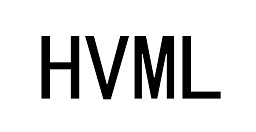
2) 呼噜猫 is a registered tradmark of FMSoft Technologies in China and other contries or regions.

3) Purring Cat is a tradmark of FMSoft Technologies in China and other contries or regions.
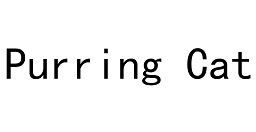
4) PurC is a tradmark of FMSoft Technologies in China and other contries or regions.

5) xGUI is a tradmark of FMSoft Technologies in China and other contries or regions.

 发表于 2022-11-30 09:31
发表于 2022-11-30 09:31
 发表于 2022-11-30 09:40
发表于 2022-11-30 09:40
 |
发表于 2022-11-30 09:59
|
发表于 2022-11-30 09:59
 发表于 2022-11-30 14:21
发表于 2022-11-30 14:21
 |
发表于 2022-11-30 19:00
|
发表于 2022-11-30 19:00
 发表于 2022-12-1 07:00
发表于 2022-12-1 07:00
 |
发表于 2022-12-1 10:22
|
发表于 2022-12-1 10:22
 |
发表于 2022-12-1 10:22
|
发表于 2022-12-1 10:22